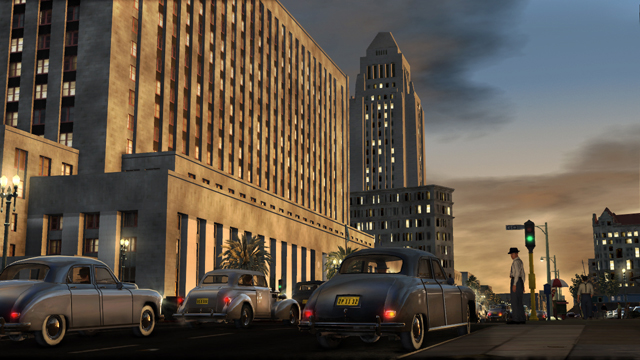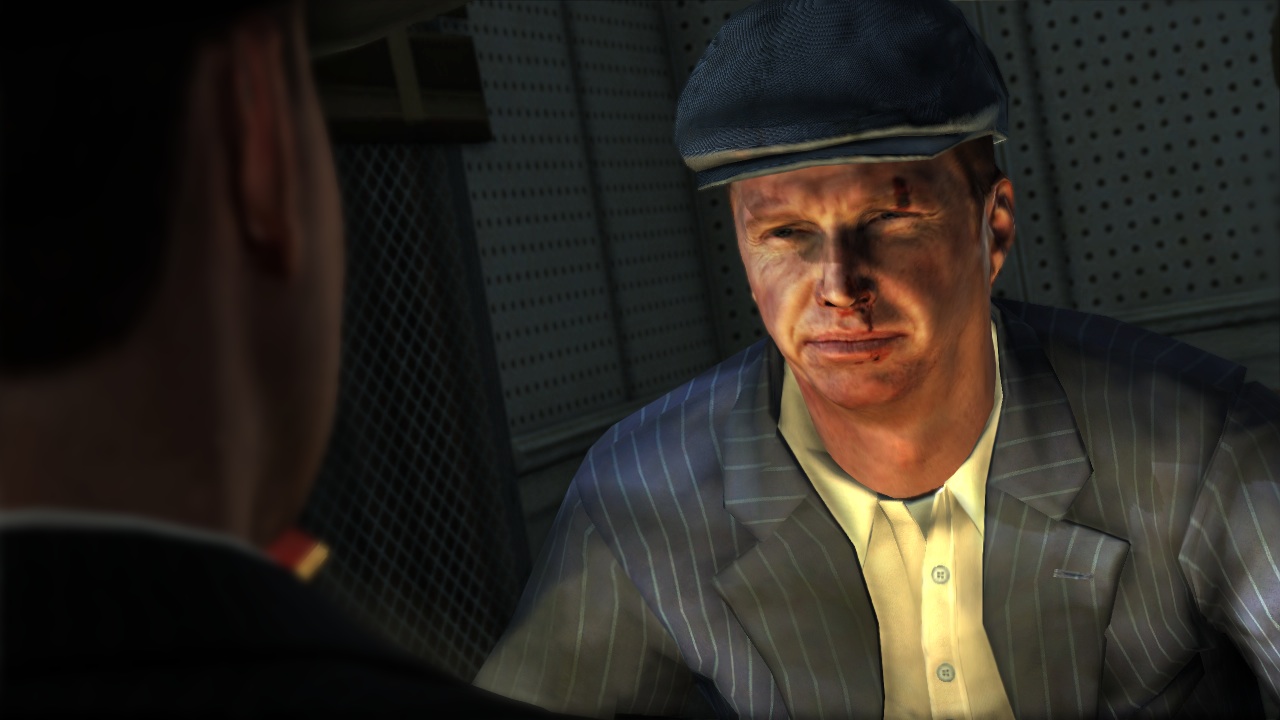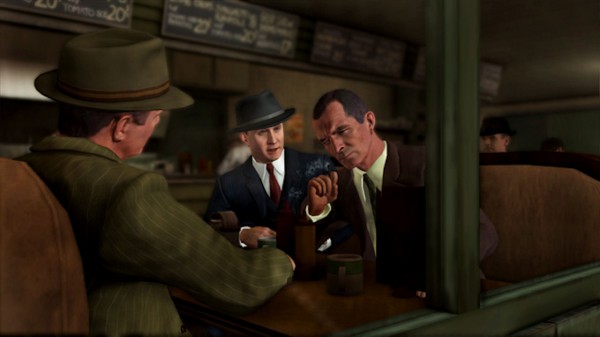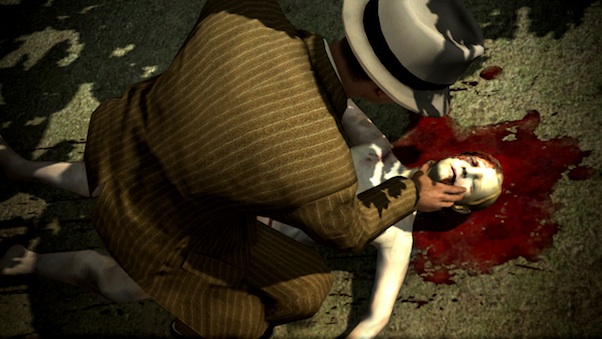
L.A. Noire challenges many of the preconceptions associated with modern gaming. What it does to separate itself from the usual action, adventure, and open-world trends, as well as the standards of acting and “maturity” in video games, can leave a player questioning whether those things were ever done correctly in the first place. Its twisting narrative, innovative gameplay, deviation from traditional implementation of genre, revolutionary acting, and perspective on maturity make the title a true gem, despite its shortcomings in basic moment-to-moment play.
The main draw for L.A. Noire has been its interrogation gameplay, in which the player has to read the reactions of the witnesses and suspects who are under questioning in order to determine whether or not they’re telling the whole story, omitting critical information, or lying blatantly. One may not think that watching people’s expressions and guessing their intentions would be interesting or challenging, but it is in fact exactly that. Some of the most intense moments of the entire narrative will occur while in the investigator’s chair with notebook in hand. Knowing what kind of person you’re questioning, catching the slightest twitch or eye shift, listening to what the person says and how they say it, and knowing whether or not you have the proper evidence to prove a lie are extremely crucial in getting what you want out of a suspect. You have to glue yourself to the screen in order to properly analyze the subject, check your evidence, and then make the most educated decision possible. The use of the game’s Intuition feature can help, but Intuition points are not infinite and using them doesn’t always guarantee a correct answer.
Although many of these interrogations don’t have a great deal of significance with regard to the overall narrative, and the consequences of failure will never prevent you from progressing, royally messing up some of these segments can make future investigations much more difficult by limiting your knowledge about a suspect or the case itself. Possessing that knowledge could change your opinion of a suspect or even make you wonder if there isn’t something bigger going on. It’s a system that allows you to make mistakes and still persevere, but also rewards those who can read people better. Unfortunately, it is not always perfect, as logically viable indictments of dishonesty can fail when two different pieces of evidence prove the same lie and the game is only looking for one correct answer, or when Detective Phelps jumps to one particular conclusion rather than to another, based on the simple “doubt” and “lie” responses available to the player. An option in the pause menu to restart interrogations instead of the one that has you restart the entire case would have been nice, too, although the same can be accomplished by hard-resetting or quitting back to the main menu and re-entering the game via the last autosave.

These interrogations spice up a process that has become typical of adventure titles. In past games from this genre, you would search for clues, watch some scenes after you find all of them, then search for more. Now instead of watching the hero question those believed to be involved or seeing the action arising from the investigations second-hand, you are able to do it yourself. You are the one asking the questions and making the deductions, traversing the game world, chasing down perps, and coming under fire, even if these segments do recycle the same activity more often than players might like. The clue-finding is still there and is one of the most crucial elements of the game. After the initial observation of a clue, indicated to the player by aural and vibrational cues, you can manipulate the object by moving it around and can sometimes interact further with an additional button press. Missing evidence can make certain questions unavailable, eliminate the opportunity to catch a lie, or even prevent insight into either the case or the grander scheme behind it. The fact that the game turns off the crime-scene music to let you know when all pieces of evidence have been found is therefore quite helpful.
The game’s story centers on Detective Cole Phelps, a World War II veteran and recipient of the Silver Star for his efforts in the Battle of Okinawa. Phelps has joined the police force in an attempt to right the wrongs he’d made during his tour of duty. Through the course of his career in the LAPD, players will see that Phelps is far from your traditional hero and much more similar to those of classic noir. He is a man trying to do his best to clean up a city, but has many flaws that will eventually reveal themselves and come back to hurt him. Each case has its own compartmentalized story showing the dark side of Los Angeles’ golden age, but eventually begin to tie into an engrossing overall plot. It will take a while to get there, feeling a bit drawn out within each of the four departments Phelps transitions to, but once the overall narrative does begin to come together, the tale will present plenty of twists and turns that keep you guessing just how deep the corruption in the City of Angels goes, and to what end. In the end, Phelps’ search for truth and desire to set things right bring about a conclusion true to the genre that inspired it.
No game in this day in age can have a quality narrative without good acting to back it up. A decade ago that meant having a good voice actor behind the animations. In recent years, it’s meant a strong voice that can also provide motion capture. L.A. Noire has changed that once again thanks to its revolutionary facial capture technology. Emotions, from fear and anger to excitement and surprise, have been mapped naturally to each of the characters’ faces. But that’s not entirely thanks to the technology, as all of the actors and actresses, from leading roles to the minor witnesses and suspects, hit their marks wonderfully and pull you in regardless of whether you’re watching a cutscene or conducting an interrogation. This effort to produce realistic in-game conversation between believable characters is something from which other developers would benefit.

The audio department also excels in L.A. Noire. From the moment the first jazzy tune plays on the main menu, you are drenched in the atmosphere of the 1940s. Once inside the game, the rest of the soundtrack does its era and genre justice. The original score adds tension to certain scenes, car radios create ambiance with a mix of music and occasional police chatter, and special tunes and chimes help with investigations and interrogations. These all contribute to an exceptional auditory experience that allows you to become lost in the early years of post-war-era America.
Immersion in any game is dependent on a memorable setting, and Team Bondi’s 8-square-mile re-creation of 1947 Los Angeles does just that. The included portion of the city is so massive that you will barely care that it isn’t a representation of the whole thing. What has been put together, however, makes you feel as if you’ve jumped back in time. The old-school traffic lights, post-war advertisements, vintage vehicles, neon lights, and architecture ooze golden-era L.A.
Team Bondi also does a great job of continuing a growing tradition from last year’s Mafia II by making the open world much more a setting and character than a sandbox in which players do whatever they please. Waypoints remind you that you are always in the middle of a case, encouraging you to not be distracted from the narrative. Secondary gameplay options are limited, but do exist for those who wish to explore. You won’t be given the option to hang out with the cast to bowl or to play darts, but you can gather cars and golden film reels, discover famous landmarks, or fight incidental street crimes, which all offer a nice break from the intellectual challenges of interrogations. The overall take on open-world design allows players to feel like they are actually immersed in the game’s setting, but at the same time reminds them that they always have more pressing matters to attend to.
If there is one thing that L.A. Noire does exceptionally well, it’s that it changes the way we look at how mature content should be exhibited in games. The title’s M rating isn’t shoved down your throat by way of awkward sex scenes or excessive blood and violence; these things are used appropriately to ground the game in realism. A detective will be forced to inspect those recently deceased for clues, sick murderers will strip their victims of clothing to humiliate them, and coming upon someone who has overdosed will mean that the presence of the drugs and signs of use will be apparent. None of it is unwarranted. The use of these devices are all meant to show the gritty, dark, and ugly side of life that tends to reveal itself quite often during detective work. It’s a humbling experience that shows not everything is as pleasant as it appears on the surface.

When not investigating crime scenes and interrogating suspects, gameplay varies itself between four different means of action. Traditional shootouts handle themselves essentially the same as you would assume if you’ve ever played Grand Theft Auto IV or any other third-person action game. Fist fights use the basic dodge, attack, grapple, and finishing move mechanics. Car chases involve avoiding buildings and vehicles, ducking into alleyways, and disabling the vehicles you pursue by having your partner blow out the tires or taking action yourself and ramming into the enemy car to stop it. Foot chases force Phelps to pursue a suspect and either tackle the perp to the ground, fire a warning shot to get them to freeze, or simply gunning them down as before. Finally, tailing suspects on foot and car force players to test their stealth skills by maintaining distance, keeping behind cover, and staying incognito so as to avoid alerting the target. These provide some deviation from collecting evidence and asking questions, but their repetitive nature tends to detract dramatic value from the game as a whole.
While a predominantly positive experience, L.A. Noire is not flawless. Texture pop-ins while traversing the city of Los Angeles or even walking from one area to the next are frequent, and can become irritating. On extremely rare occasions, a car will simply materialize itself out of thin air and drive down the road after dropping to the ground, or disappear when it stops at a red light. Other technical glitches, such as characters’ occasional inability to enter car doors, luckily do not occur during crucial moments.
Despite these shortcomings, it’s hard to argue that L.A. Noire has done what few games have done before. It does a very good job of blending genre, revolutionizes digital acting, and gives a fresh take on what it can mean to be a mature title. The story is drawn out at times, but provides a great slice of classic noir that will reward players who remain engaged and invest the time to reap its benefits. Its audio boasts one of the best soundtracks of the year. The technical difficulties and small gameplay stumbles come dangerously close to breaking immersion, but luckily the world of 1947 Los Angeles as imagined by Team Bondi, combined with the game’s advances, make L.A. Noire one no dedicated gamer should miss.

















